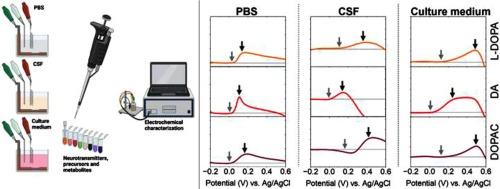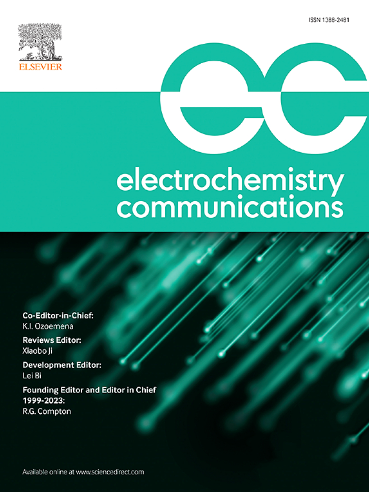胺类神经递质的电化学检测在缓冲溶液、体内和细胞培养系统中存在巨大差异
IF 4.7
3区 工程技术
Q2 ELECTROCHEMISTRY
引用次数: 0
摘要
神经递质的检测需要高灵敏度和高时间分辨率,因此电化学技术成为传感机制的首选。然而,胺类神经递质的电化学检测高度依赖于电极表面条件,因此在清洁缓冲溶液中获得的结果并不能直接用于体内或体外的实际测量环境。在这些更为复杂的电解质溶液中,抗氧化剂和表面吸附分子的存在会极大地改变胺类神经递质、其前体和代谢物的氧化还原特性。因此,我们使用由单壁碳纳米管网络制成的高灵敏度电极,研究了它们在磷酸盐缓冲盐水(PBS)、脑脊液(CSF)和细胞培养液中的氧化还原特性。相应地,电化学反应动力学在 PBS 中比较容易,而在培养基中比较缓慢。令人惊讶的是,与其他电解质相比,分析物分子结构在 CSF 中的重要性要大得多,但与在 PBS 中测量的反应动力学相比,CSF 中的反应动力学仍然普遍较慢。虽然 CSF 中也含有 L-抗坏血酸和尿酸这些电化学活性干扰分子,但它们在体外环境中要么完全不存在,要么可以省略。与此相反,培养基中的表面吸附分子浓度更高,会导致电极严重堵塞,从而降低灵敏度。随着体外脑芯片应用的迅速普及,直接比较这些不同的实验设置对于了解它们对电化学传感器的影响至关重要。本文章由计算机程序翻译,如有差异,请以英文原文为准。

Electrochemical detection of amine neurotransmitters is drastically different in buffer solutions, in vivo, and cell culture systems
Detection of neurotransmitters requires high sensitivity and temporal resolution, favoring electrochemical techniques for the sensing mechanism. However, electrochemical detection of amine neurotransmitters is highly dependent on electrode surface condition and thus, results obtained in clean buffer solutions are not directly applicable to the real measurement environment in vivo or in vitro. In these more complex electrolyte solutions, the presence of antioxidants and surface-adsorbing molecules drastically alters the redox characteristics of amine neurotransmitters, their precursors and metabolites. Accordingly, we surveyed their redox characteristics in the phosphate buffered saline (PBS), cerebrospinal fluid (CSF) and cell culture medium, with high-sensitivity electrodes made of single-walled carbon nanotube network.
The concentration of surface-fouling molecules was lowest in the PBS and highest in the culture medium. Accordingly, electrochemical reaction kinetics were facile in the PBS and sluggish in the culture medium. Surprisingly, analyte molecular structure had much more importance in the CSF compared to other electrolytes, however the reaction kinetics remained to be generally slower in the CSF compared to when measured in the PBS.
Whereas the CSF also contains L-Ascorbic acid and uric acid that are electrochemically active interfering molecules, they are either completely absent or can be omitted in the in vitro setting. On the contrast, the culture medium contains substantially higher concentration of surface-adsorbing molecules that causes more significant fouling of electrode and thus loss of sensitivity. As the in vitro brain-on-a-chip applications are rapidly being adopted, direct comparison of these different experimental settings was essential to understand their implications for electrochemical sensors.
求助全文
通过发布文献求助,成功后即可免费获取论文全文。
去求助
来源期刊

Electrochemistry Communications
工程技术-电化学
CiteScore
8.50
自引率
3.70%
发文量
160
审稿时长
1.2 months
期刊介绍:
Electrochemistry Communications is an open access journal providing fast dissemination of short communications, full communications and mini reviews covering the whole field of electrochemistry which merit urgent publication. Short communications are limited to a maximum of 20,000 characters (including spaces) while full communications and mini reviews are limited to 25,000 characters (including spaces). Supplementary information is permitted for full communications and mini reviews but not for short communications. We aim to be the fastest journal in electrochemistry for these types of papers.
 求助内容:
求助内容: 应助结果提醒方式:
应助结果提醒方式:


